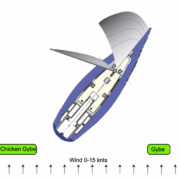Gybe Boo Boo
The forecast was for 30 gusting to 40 knots and we were set to do race 10 – the final in the series. After Race 9 we were coming first with a 3 point lead. All we had to do was do ok and the series was ours.
We were racing on Charmonet a Beneteau First 45. On the downwind leg before the last mark to home, we were flying the gennaker and going fast. The wind had not dropped below 30 knots all day and the race was exciting. It was time to gybe to the mark, but it did not go well. In fact, pretty disastrous!
Gybing can be pretty dangerous at the best of times. The boom comes across very fas,t and you’ve got to time the turn and the crew actions just right. At 30 knots, it’s really really dangerous.
Getting the mainsail in prior to the turn is essential – otherwise the boom slamming across to the other side can break the gooseneck (Boom attachment to the mast). Additionally, the main sheet comes across the cockpit really fast and can hurt the crew. The trick is, however, that the mainsail has to be let out very fast after the gybe, otherwise the boat will round up into the wind and heel the boat way, way over.
In our case we neglected to get the mainsail in before the turn. The force on the mainsail was so high from the wind that it was taking too long to winch it in before the gybe was required. During the gybe, the helmsman was crack-whipped across the top of his hands on the wheel by the mainsheet as it flew across. The whip on the hands was so hard and fast that it incapacitated the helmsman, causing a trip to the emergency medical facility after the race. Fortunately, the injury was just a bad skin lesion and swelling without broken hand bones. The boom slammed across so fast that it actually surprised me that it did not break the gooseneck.
On top of all that (yes there is more), there was so much distraction going on that the gennaker sheet trimmer did not let the gennaker float forward so that it would gybe around the front of the forestay. Instead, as the boat came through the wind, the gennaker went inside the forestay and then flogged around bad enough so that it shredded the gennaker.
I’ve created a couple of animations to show some gybing concepts. The first shows gybing a mainsail and a genoa. Notice the main is winched in first before the turn. When ready, the turn is made and then the main is let out fast. The concept of chicken gybe is also shown in this animation. A chicken gybe is simply a tack all the way around. It’s much safer with much less stress on the boat and crew. A note, however, is that the sheets must be tightened in high winds as the boat comes through the wind to stop the sheets from whipping. If possible, the chicken gybe should be done after about 15 knots of wind.
This second animation is one with a gennaker. It shows how the gennaker sheet must be let forward so that the gennaker gybes around the outside of the forestay.
The video below an excellent 9-minute compilation of our 3-hour adventure put together by Colin Preston from Sail-World. Near the end you can see our shredded gennaker :(.









